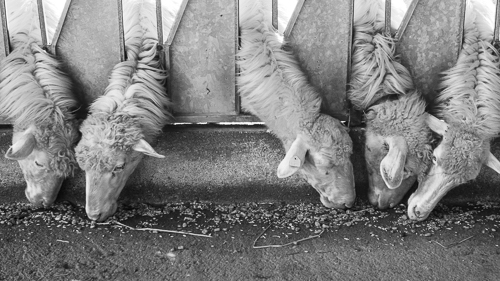Traversing the lowlands of Campidano and driving on the country road between Luras and San Nicolò d’Arcidano, we arrived at the family-driven farm and guest house Su Sattisceddu. Mauro, the eldest son, was expecting us and he kindly showed us the way to the farm, situated a short distance from the guest house, where his father Giuseppe is raising sheep.
Before, this farm was occupied with selling cheese and meat, now they produce and sell milk to a cooperative called L’armentizia moderna located about 30 kilometres away in the region of Guspini. However, they prefer selling rams selected for breeding. In fact, select sheep raised at the farm are shown at national fairs.
Mauro, being an expert on Sardinian sheep, explained together with his father, the characteristics of a good Sardinian sheep include: completely white fleece without any stains, long and even woolen fleece, no horns and a perfect line of the lower back.
Having showed us the the way to the farm and explained how to judge the characteristics of sheep, he left and let his father Giuseppe show us around the farm.
First, he showed us a group of sheep, inside a fence, which were preparing for birth and to which he gave some cereals in order to show us that the sheep get their required daily food rations in a trough. Instead, regarding alfalfa and hay, Giuseppe leaves it inside the fence, letting the sheep eat it whenever they want.
He also showed us the milking room where food is distributed evenly in a trough, then the sheep are allowed to enter, but they have to put their heads through a rack and when all the animals have arrived, the farmer locks the rack such that the sheep have to stay, facilitating the milking.
Moreover, Giuseppe explained that sheep need to eat continuously 24 hours a day, and like us, they need a varied diet. Thus, in addition to the grass they are grazing, they are fed hay, straw, etc. It’s also important to give them concentrated animal feed such that they don’t lack any nutrients. Usually, the food additives consist of seeds and legumes like beans mixed with a pulp of beetroot and cereals like barley, all of which are cultivated by Giuseppe. This highly concentrated mix is mainly given to the sheep in winter when the meadows run out of edible plants and the sheep are most vulnerable to diseases. That is during the period when the sheep are pregnant, when they are bearing lambs and the succeeding period of lactation.
In fact, it’s very important that the sheep, being ruminants, consume the right quantity of chewable fibre, fundamental for the health of sheep.
Giuseppe also showed us some fields sown with seeds which would give rise to plants most suitable for grazing by sheep, among which are ryegrass, Egyptian clover and sulla, the last one being much appreciated by animal breeders. In fact, it is used as fodder of prime quality, containing lots of nutrients and being rich in proteins. It’s drought resistant and, being a legume, it captures nitrogen from the atmosphere and gives it to the soil in which it is growing. Thus, it is often used between cultivation of plants which only extract nutrients from the soil.
Being shown around the farm, we saw several meadows where the sheep could graze. Giuseppe sows the meadows some time between October and December such that there will always be a meadow on which the sheep can graze.
Giuseppe has been a sheep farmer for many years and he’s very passionate about his work, bringing forth an activity which was started by his great-grandfather and he really hopes that his children will do likewise.

